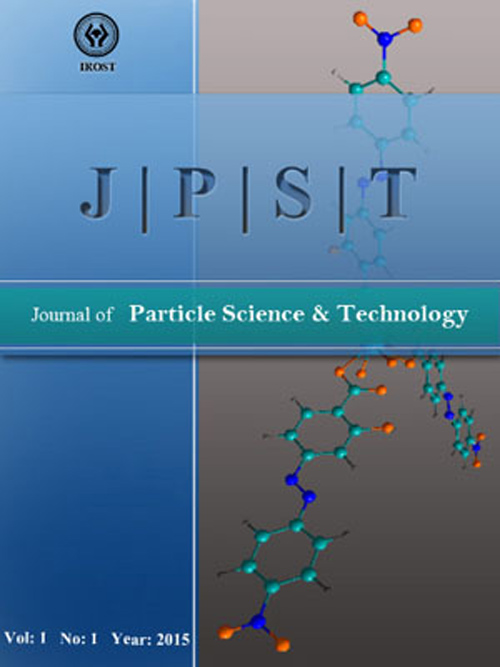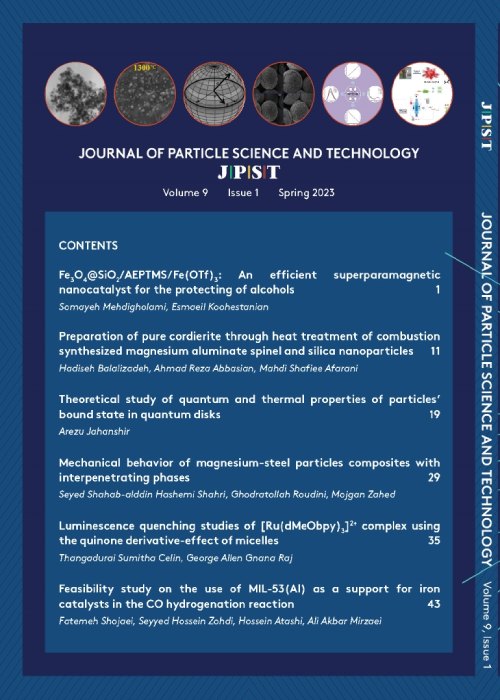فهرست مطالب

Journal of Particle Science and Technology
Volume:1 Issue: 4, Autumn 2015
- تاریخ انتشار: 1395/09/28
- تعداد عناوین: 6
-
-
Pages 195-204An ab initio study has been performed for the electronic, spectroscopic, and chemical properties of the most stable configuration of the (CdO)n nanoclusters by employing B3LYP-DFT/LanL2DZ method. Different isomers were optimized to obtain structural stability and numerous chemical parameters such as dipole moment, ionization potential, etc. We report here the vibrational frequencies of the most stable configuration of (CdO)n nanoclusters. We found that, the highest vibrational frequencies of each (CdO)n nanoclusters arise from the asymmetrical stretching vibrations while the lower frequencies correspond twisting, bending and the out-of-plane vibrations of Cd and O atoms. Our results show that, the (CdO)2 nanocluster with the ring structure and the smallest HOMO-LUMO gap (HLG = 1.897) has the smallest hardness (ɳ = 0.95) and consequently is expected to has the highest chemical reactivity.Keywords: Nanocluster, Cadmium Oxide, IR Spectra, DOS, DFT
-
Pages 205-213In this investigation, rheological properties of three different polymer-modified bitumen compounds containing recycled polyethylene terephthalate (R-PET), crumb rubber (CR) and poly (styrene-butadiene-styrene) (SBS) are evaluated and compared. The modified samples were tested by a dynamic shear rheometer (DSR) where complex modulus (G*), phase angle (δ) and rutting resistance (G*/Sinδ) of specimens were measured at different temperatures. The obtained results show that the optimum rheological properties will be gained when 7% wt. of a modifier mixture containing R-PET/CR (90/10 weight ratio) is added to the bitumen. In comparison with un-modified bitumen, the one modified by the latter modifier shows phase angle shift 68.9 oC, complex modulus 2190 (Pa) and rutting resistance 2520 (Pa), at temperature 80 oC. Generally, addition of the polymeric modifier increases complex modulus, rutting resistance and rigidity of the bitumen while a little decrease in phase angle is also observed.Keywords: bitumen, polymeric, modified bitumen, rheology, crumb rubber, poly (ethylene terephthalate)
-
Pages 215-223Petrochemical manufacturing wastewaters often contain a high concentration of biodegradable com-pounds that possess either toxicity or activity inhibition to the biological unit. In this paper, COD removal from Petrochemical wastewaters by electro-Fenton process was studied. The effect of operating conditions such as reaction time, current density, pH, H2O2/Fe2 molar ratio, and H2O2 of petrochemical wastewater (PW) (ml/l) on the performance of the process has been studied. The experimental results showed that COD was 75.52% removed by the reaction with OH radicals generated from electrochemically assisted Fentons reaction. With our cell design, the higher oxidation rate has been obtained applying a current of 57.01 mA, at pH 2.92 and in the presence of 0.3 mM Fe2 as catalyst and at reaction time of 86.33 minutes.Keywords: Electro-Fenton, Nano iron particles, COD, Petrochemical wastewater
-
Pages 225-240This article deals with the study of the two-dimensional mixed convection magnetohydrodynamic (MHD) boundary layer of stagnation-point flow over a stretching vertical plate in porous medium filled with a nanofluid. The model used for the nanofluid incorporates the effects of Brownian motion and thermophoresis in the presence of thermal radiation. The skin-friction coefficient, Nusselt number and local Sherwood number as well as the velocity, temperature and concentration profiles for some values of the governing parameters were presented graphically and discussed in detail for both the cases of assisting and opposing flows. It was observed that, the magnitude of the reduced Nusselt number decreases with the increases in the Brownian motion and thermophoresis effects for both cases of buoyant assisting and opposing flows. In addition to, the local Sherwood number increases by increasing the Brownian motion in both cases of buoyant assisting and opposing flows. A similar effect on the local Sherwood number was observed when thermophoresis effects decreases.Keywords: MHD mixed convection, Stagnation-point flow, Stretching vertical plate, Nanofluid, Brownian motion
-
Pages 241-251In this research, the influence of adding micro- and nano- sized calcium carbonate powders to nylon-66 was investigated. Mechanical properties of micro and nano- composites, including tensile strength, elongation, and Youngs modulus, before and after ageing, were determined and analyzed. For this purpose, micro- and nano-sized CaCO3 particles were used as fillers to prepare micro-composites (conventional composites) and nano-composites via a polymer solution method. It was observed that tensile strength and youngs modulus increased and elongation decreased with increasing CaCO3 particles in the composites. Also, nano-composites had higher strength and modulus than micro-composites. Theoretical prediction of elastic modulus was carried out using rule of mixtures, Guth, NicolaisNarkis, HashinShtrikman, and HalpinTsai equations. Calculated results show that these equations are not suitable for accurate prediction for the work carried out. However, these models can be used with confidence for the prediction of elastic modulus because experimental results are higher than the calculated values.Keywords: Additives, Nylon-66, Composites, Mechanical properties, Rule of mixtures
-
Pages 253-263A series of tri- and tetra- substituted imidazoles were synthesized from benzyl, aldehyde and ammonium acetate in the presence of zeolite as an ecofriendly reusable catalyst under microwave irradiation in the absence of solvent. The yields are high to excellent and the use of microwave irradiation reduces reaction times to few minute.Keywords: Zeolite, One-pot synthesis, Solvent, free, Trisubstituted imidazoles, Tetrasubstituted imidazoles


